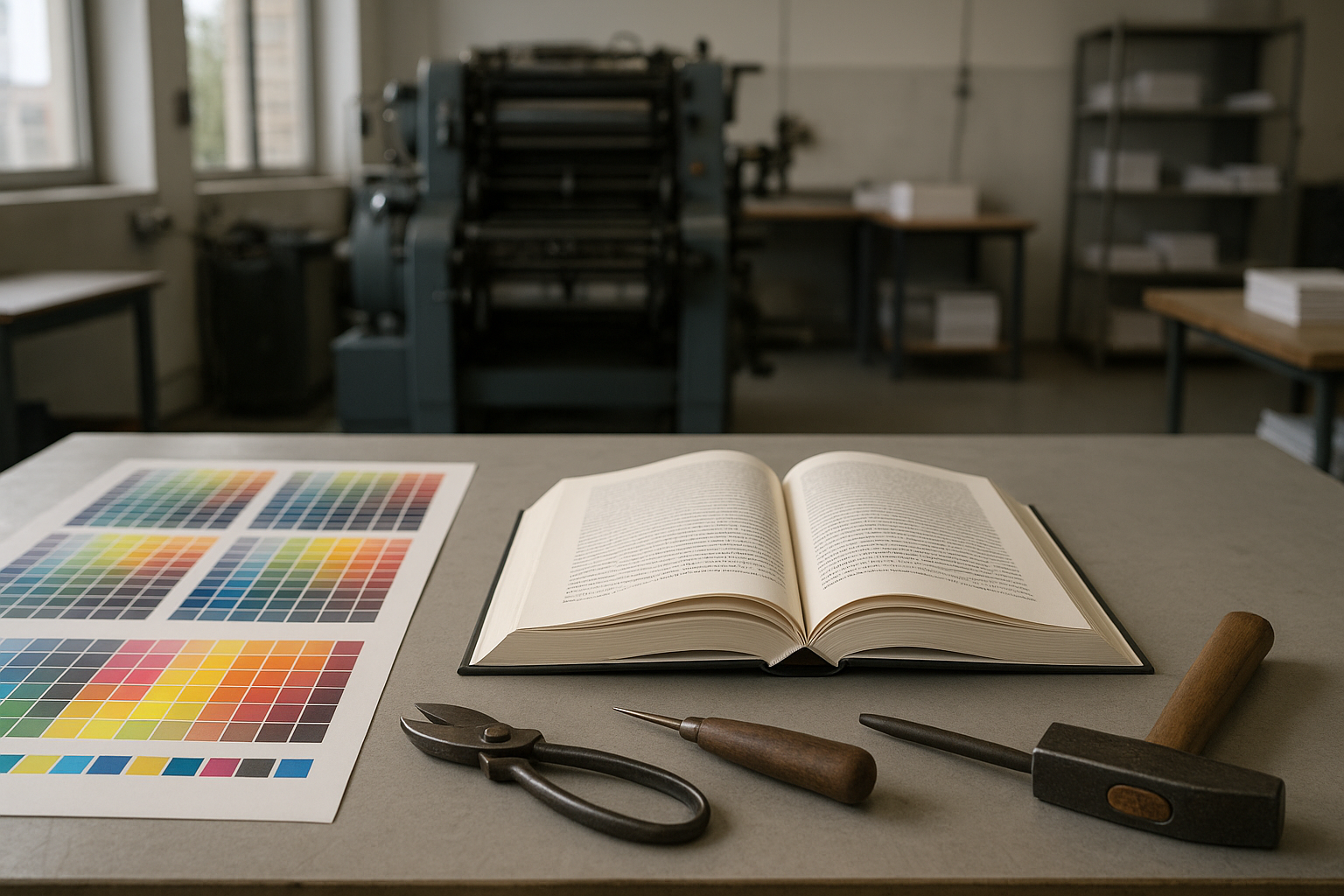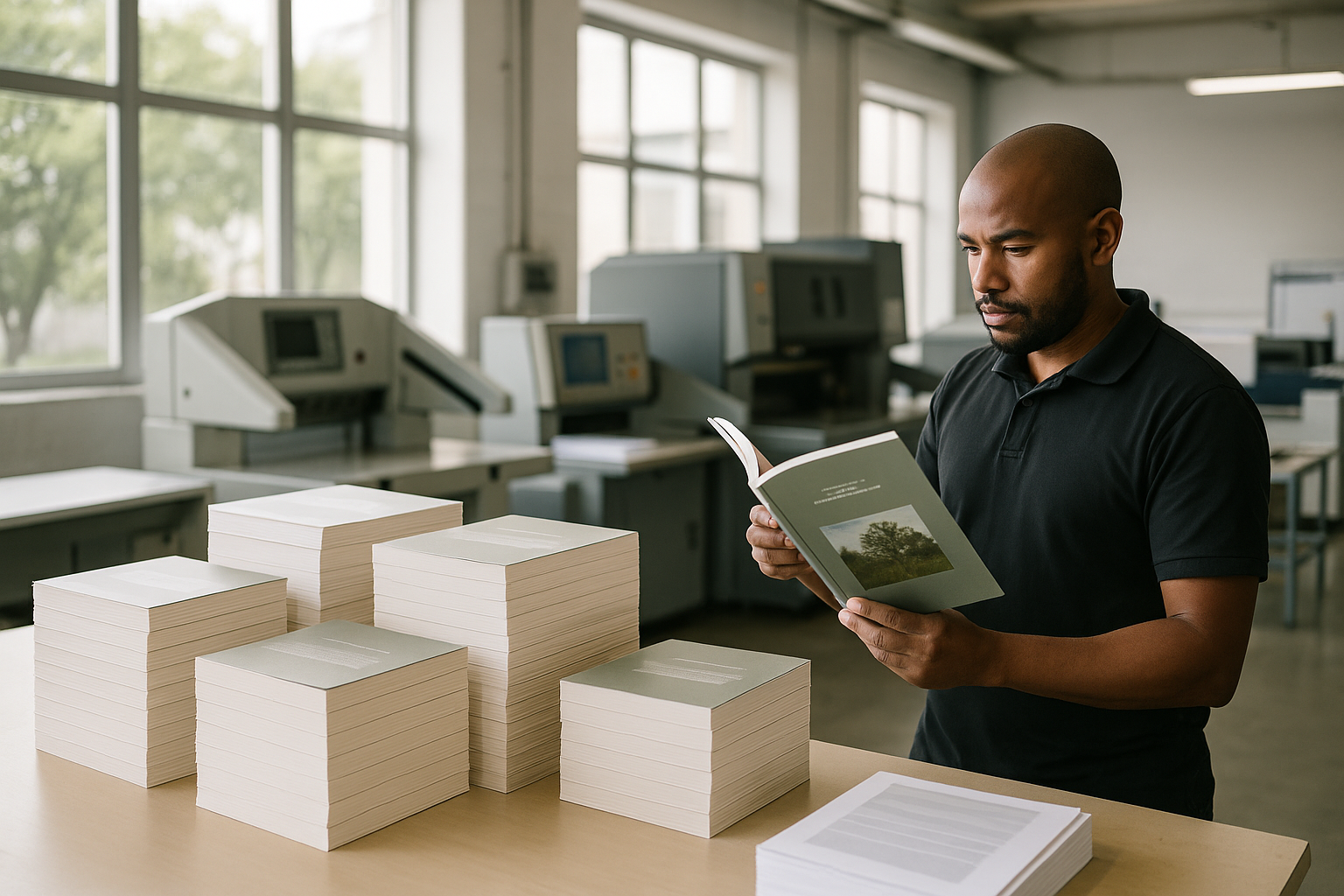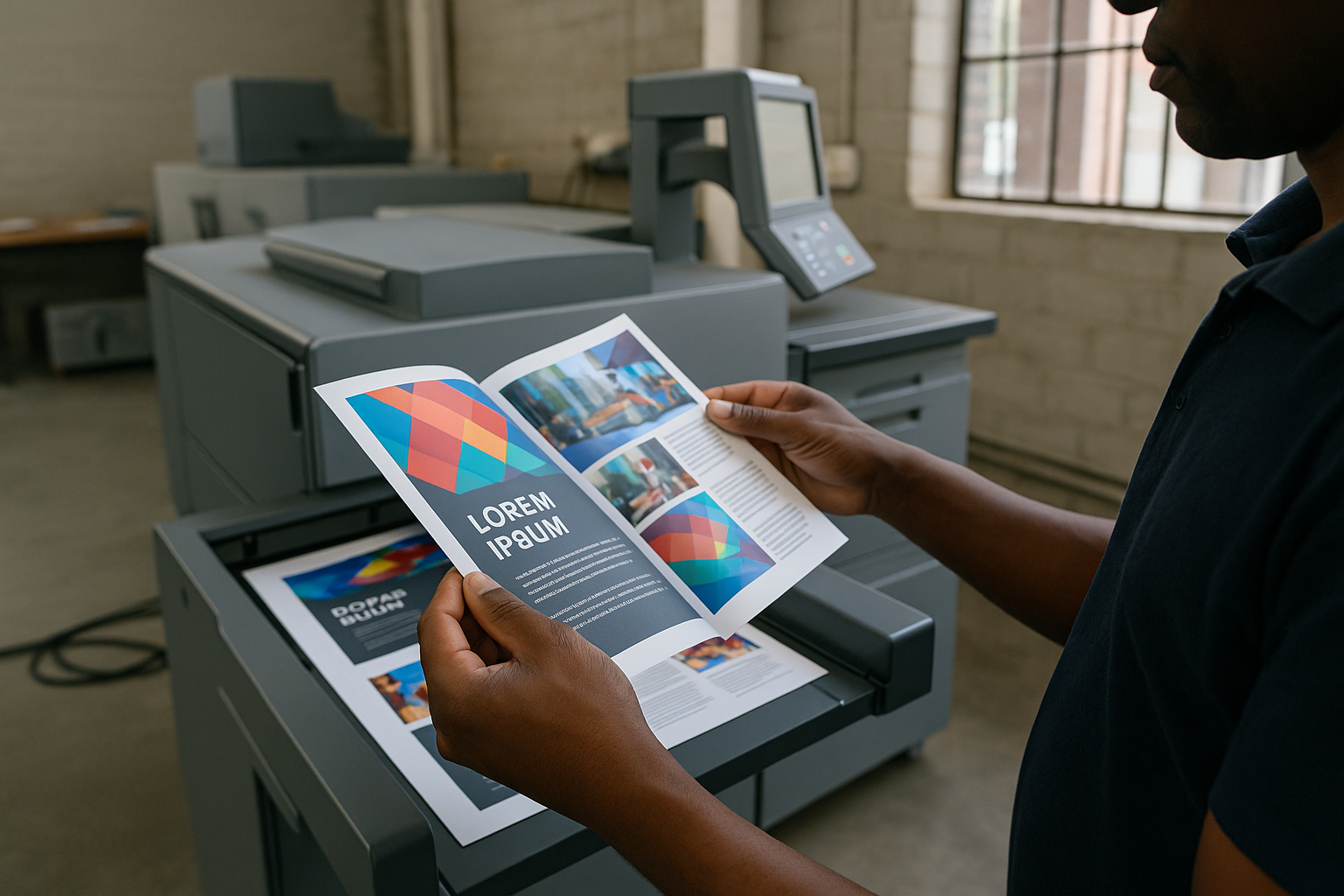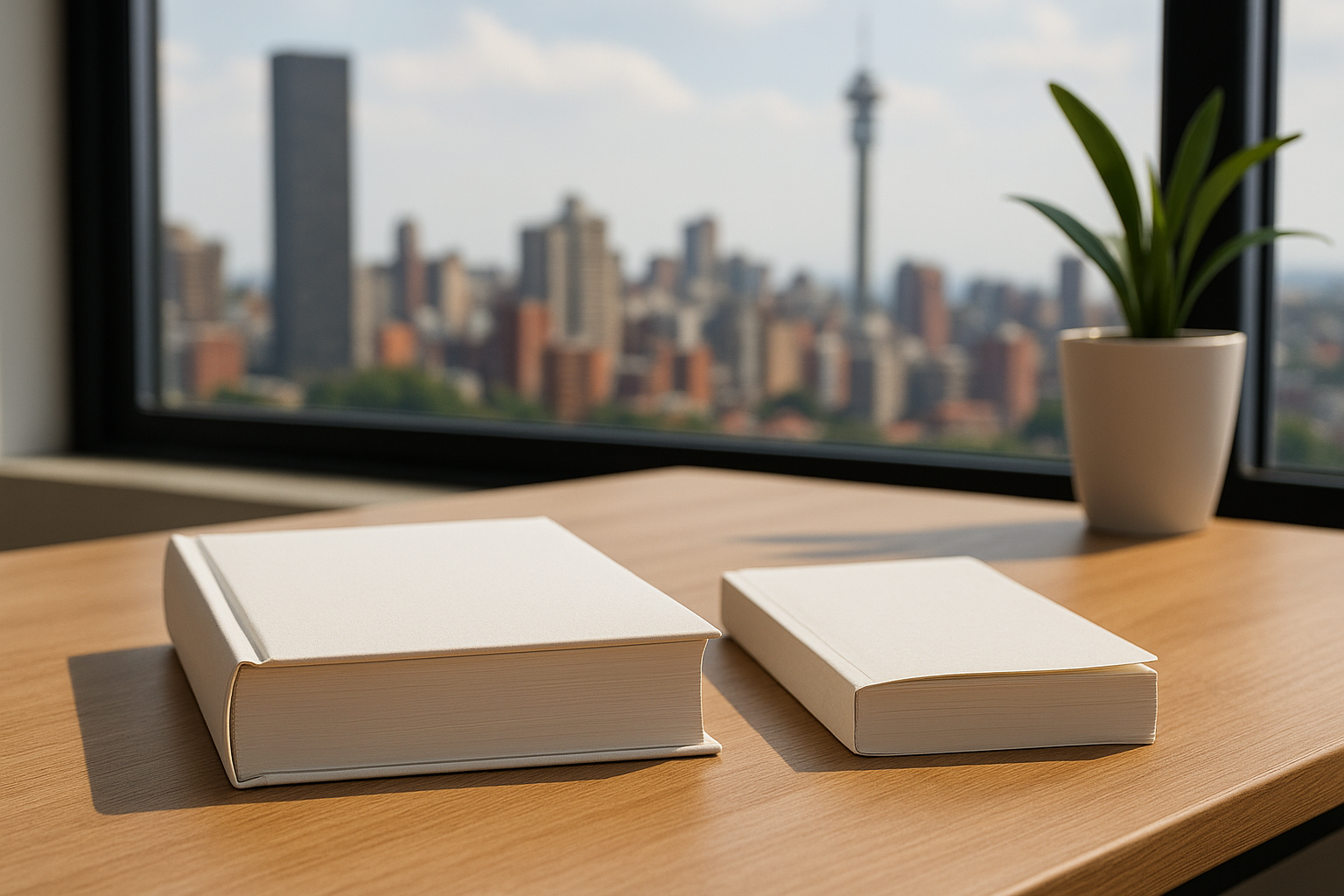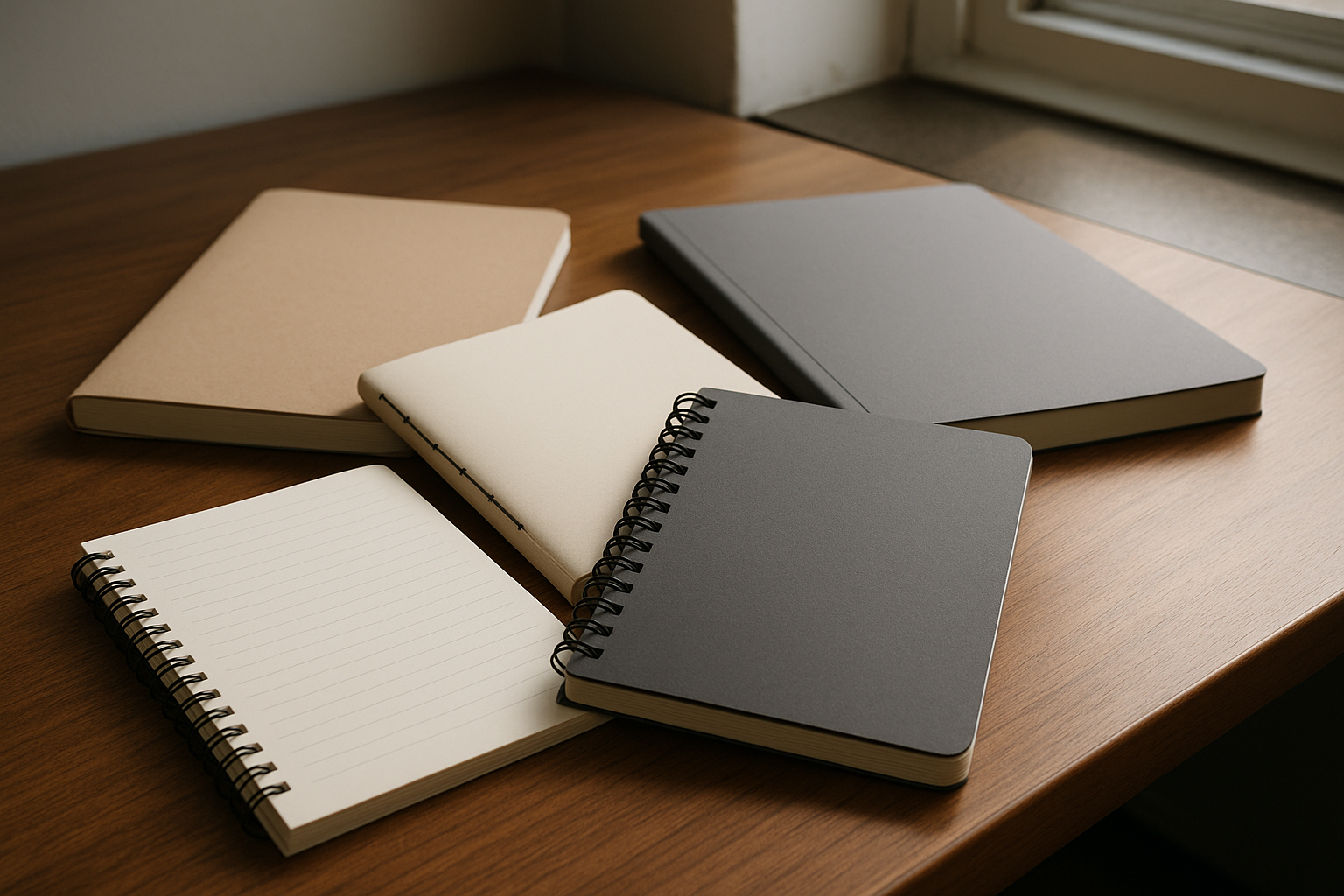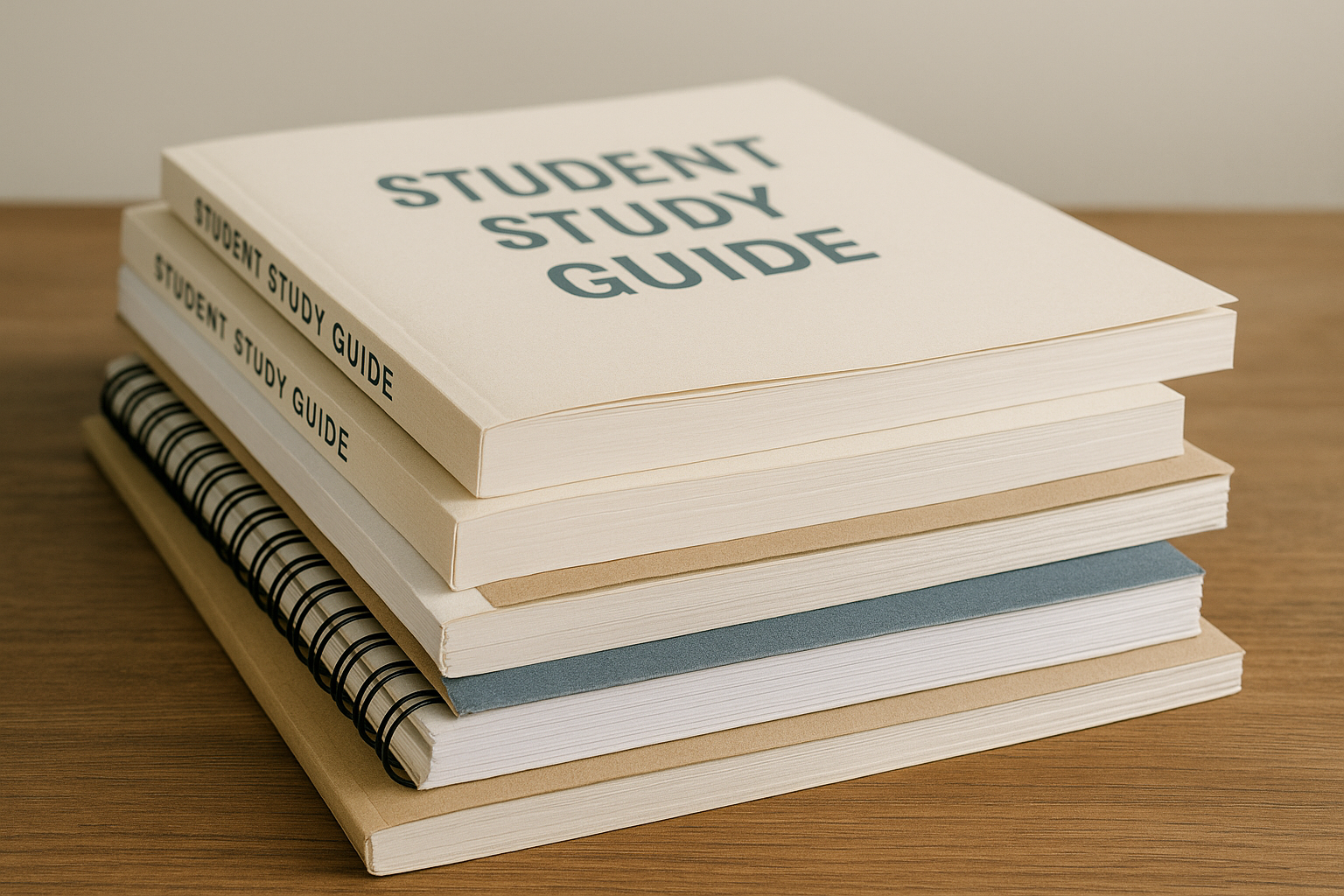Custom book printing is the smartest step when you want a tangible, credible product that tells a story, sells an idea and serves a purpose — from school textbook printing to custom publishing for small businesses across South Africa.
What is custom book printing and how does it differ from generic marketing materials?
Custom book printing refers to the creation of books tailored to a specific content, format, finish and audience. Unlike generic marketing materials such as mass-produced brochures or flyers, custom book printing allows for ISBN assignment, pagination, durability and binding choices that suit textbooks, training manuals and branded company books. This makes it a preferred option in the commercial printing and educational printing industries where longevity and authority matter.
Custom book printing focuses on:
- Structured content (chapters, indices, front/back matter)
- Multiple binding and finish options (casebound, perfect bound, saddle-stitched)
- Unique sizing, paper stock and print runs (bulk educational printing for schools or short-run print-on-demand)
For example, booklet printing or brochure printing serve marketing and promotional needs, but a textbook or catalogue requires the precision and permanence of book printing.
Why custom book printing beats generic marketing materials for credibility and sales
Books convey authority. A well-printed book with an ISBN, professional layout and binding signals trust in ways a flyer cannot. That trust converts into sales, institutional adoption and long-term brand value. In South Africa, schools and training providers routinely prefer printed training manuals and textbooks over loose leaflets because they align with curriculum planning and school term preparation.
Key advantages include:
- Perceived value: books are kept, referenced and resold.
- Longevity: durable bindings for repeated classroom or field use.
- Discoverability: ISBNs and cataloguing make books findable in libraries and retailers.
According to the International ISBN Agency, ISBNs are administered by national agencies to support discoverability and distribution of books worldwide. For authors and institutions seeking legitimacy, a printed book with an ISBN is a different category from typical marketing collateral. (See the ISBN entry on Wikipedia for an overview.)
How do costs compare: is custom book printing more expensive than brochures and flyers?
On a per-unit basis, a custom printed book will usually cost more than a single brochure or flyer because of paper weight, binding, pagination and finishing. However, when you measure cost-per-page, shelf-life and return on investment, books often perform better for educational printing, catalogue printing and custom publishing for small businesses.
Cost factors to consider:
| Factor | Impact on Cost |
|---|---|
| Print run (volume) | Bulk educational printing for schools lowers per-unit cost; print-on-demand suits small runs |
| Paper and binding | Higher quality paper and casebinding increase durability and price |
| Finishes (lamination, spot UV) | Custom print finishes raise production cost, but improve longevity and perceived value |
| Delivery and distribution | Nationwide print delivery across South Africa adds logistics costs |
In practice, schools selecting school textbook printing or institutions ordering training manual printing opt for bulk runs to secure cost-effective print solutions and fast turnaround printing ahead of term starts.
What are the production steps from manuscript to ISBNed book?
The pathway from idea to ISBNed book crosses editorial, design, production and distribution stages. Each step matters to ensure the final product serves its purpose, whether it’s a school textbook or a branded corporate book for events and promotions.
- Manuscript development and editing — content clarity and quality control.
- Design and layout — pagination, fonts, images and accessibility considerations.
- Proofing and prepress — digital proofs & colour checks for litho and digital printing.
- Printing and binding — choose from saddle stitch, perfect bind or casebound finishes.
- ISBN registration and barcode assignment — required for retail distribution and libraries.
- Distribution and delivery — bulk educational printing often includes door-to-school delivery across South Africa.
According to UNESCO, printed materials remain central to education and literacy globally, reinforcing why quality book production is important for schools and training organisations.
Which printing methods suit different book types?
Choosing the right printing method depends on volume, budget and turnaround. Litho and digital printing are both widely available in commercial printing operations across South Africa and each has strengths.
- Offset (litho) printing: best for large runs like school textbook printing and catalogue printing — cost-effective per unit at scale and high colour fidelity.
- Digital printing: ideal for short runs, customization and print-on-demand — lower setup costs and quicker turnaround for training manuals or limited catalogue runs.
- Specialist binding and packaging printing: required for hardcover books or boxed sets used in events and promotions.
For many clients, a hybrid approach works: litho for large textbook runs and digital for brochures, newsletters and small-business marketing materials such as business card printing.
How do ISBNs, barcodes and distribution help sell a printed book?
An ISBN uniquely identifies a book and facilitates ordering, cataloguing and sales through retailers, libraries and distributors. Registering an ISBN transforms a printed manuscript into a market-ready product. Barcodes derived from ISBNs enable point-of-sale scanning in bookstores and online retailers. Without an ISBN, a publication is often treated as promotional material rather than a catalogued book.
Practical outcomes of ISBN registration:
- Retail channels can list and stock your book.
- Libraries and academic institutions can catalogue it formally.
- It supports rights management and metadata distribution for discoverability.
According to the International ISBN Agency, ISBNs are a core part of the global book supply chain.
What finishing options make a printed book stand out?
Finishes are a key differentiator between a mundane printed piece and a memorable volume. Custom print finishes improve durability and visual appeal — critical for school textbooks, corporate catalogues and limited-edition books.
- Lamination (matte or gloss) for cover protection
- Spot UV for highlights on covers and chapter tabs
- Foil stamping on titles for premium feel
- Specialty bindings (sewn signatures) for long-lasting textbooks
When planning bulk educational printing for schools, choose finishes that survive heavy classroom use while remaining cost-effective. Eco-friendly printing options such as recycled stocks and soy-based inks are also available to reduce environmental impact.
Can small businesses use custom book printing for marketing and training?
Absolutely. Small businesses often underestimate the power of printed books. Whether it’s a customer handbook, a branded company history, or a training manual for staff, custom book printing offers a tangible tool that supports onboarding, loyalty and credibility.
Common small-business uses:
- Training manual printing to standardise employee learning
- Booklet printing for product guides and service catalogues
- Catalogue printing for product ranges and pricing
Printed books last longer than ephemeral marketing materials and can accompany digital marketing to create an integrated omnichannel strategy. Print delivery across South Africa means businesses nationwide can access custom print services with fast turnaround printing when events and promotions require it.
How long does custom book printing take and can printers meet tight deadlines?
Turnaround depends on scope. A short run of a simple booklet might be completed in days with digital printing, while large hardcover textbook runs using litho can take several weeks including proofs and binding. Many commercial printers in South Africa offer rush services and staged delivery for bulk educational printing to meet school term preparation deadlines.
Typical timeframes:
- Digital short runs: 1–7 business days
- Offset medium to large runs: 2–6 weeks
- Casebound/hardcover projects: 4–8 weeks with prepress and binding time
Choosing the right production method and providing final files early reduces risk of delays. A reputable printer will offer a production schedule and milestone proofs for sign-off.
Are eco-friendly options available for custom book printing?
Yes. Eco-conscious publishers and institutions can choose recycled paper, FSC-certified stocks, vegetable-based inks, and waterless printing techniques. These options may slightly change cost and finish but significantly reduce environmental footprint, an important consideration for educational printing and corporate social responsibility programs.
Benefits of eco-friendly printing:
- Reduced environmental impact and support for sustainable supply chains
- Positive brand perception among students, parents and customers
- Eligibility for certain institutional procurement requirements
According to Statista, consumer demand for sustainable products has influenced packaging and print choices worldwide, prompting commercial printers to expand eco-friendly offerings.
How do I choose a printer in South Africa for custom book printing?
Selecting a printer involves evaluating experience, capabilities and service level. For commercial, educational and catalogue printing needs, look for providers who offer both litho and digital printing, custom print finishes and distribution networks for print delivery across South Africa.
Checklist when choosing a printer:
- Portfolio: examples of school textbook printing, brochure printing, booklet printing or catalogue printing.
- Capabilities: litho and digital printing, packaging printing and bindery options.
- Turnaround and logistics: can they handle bulk educational printing and school term schedules?
- Costs and quotes: transparent pricing for different print runs and finishes.
- Environmental practices: eco-friendly printing options and certifications.
For examples of specialised services, see printing pages like Books Printing, Training Manual Printing and Catalogue Printing which highlight workflows and past projects. Useful internal resources: books printing, training manual printing, textbook printing, catalogue printing, and booklet printing.
What post-print services should I expect (delivery, warehousing, reprints)?
After production, look for a printer that offers logistics support — warehousing, scheduled deliveries to schools, and managed reprint services. Many clients benefit from print-on-demand for replenishment, while larger contracts use warehousing to distribute textbooks across provincial schools or retail channels.
Typical post-print services include:
- Print delivery across South Africa with proof of delivery
- Warehousing and fulfilment for phased term releases
- Reprint and print-on-demand to control inventory and reduce waste
These services are especially important for education customers managing term schedules and for businesses coordinating events and promotions nationwide.
How do I start my own custom book project — checklist and next steps?
Starting a custom book printing project requires planning, realistic timelines, and a clear brief. Whether you’re preparing textbooks for a school, producing a branded corporate book for marketing, or creating a limited-edition title for resale, following a structured checklist helps reduce surprises along the way.
Starter checklist:
- Define scope: page count, trim size, colour vs. black & white, binding style.
- Set a schedule: include submission deadlines, proofing rounds, and delivery dates.
- Budget: request quotes for different volumes and finishes, factoring in delivery costs.
- ISBN & metadata: register your ISBNs early if retail or library distribution is planned.
- Printer expertise: work with a partner experienced in education, commercial, and catalogue printing.
When it comes to finding the right partner, there’s no need to shop around—Print It ZA is the option in South Africa. With our experience across hardcover, softcover, and educational publishing, we’ll guide you through paper choices, binding, eco-friendly options, and distribution planning. You’ll get fast turnaround, cost-effective printing, and reliable delivery nationwide—making your book project stress-free from start to finish.
